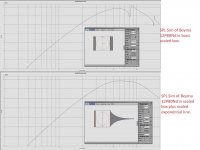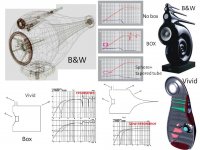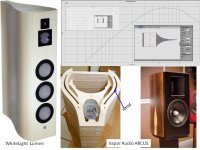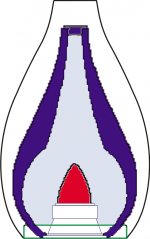I hope this is a fun and informative thread!
I have a serious question. I don't want to debate whether B&W speakers sound good. That's endless and IMHO useless. What I want to talk about is the concept of letting waves dissipate into a tapered transmission line-like enclosure instead of a sealed or ported enclosure.
To put this on a continuum, on one end we have sealed boxes, which have a serious potential to get reverberation from inside the box to come back through the driver. On the other extreme are dipole speakers with true dipole tweeters (without sealed enclosures). There is no cabinet at all.
Somewhere in the middle is the Nautilus camp. I'm not sure if it is original to B&W, but the idea of using a tapered, lossy pathway that absorbs most of the back wave. Focal uses this now in some of it's tweeter designs like the Sopra, but we also find it in other designs as well.
My point to all of this is, has anyone measured that this particular parameter is actually enhanced?
Best,
Erik
I have a serious question. I don't want to debate whether B&W speakers sound good. That's endless and IMHO useless. What I want to talk about is the concept of letting waves dissipate into a tapered transmission line-like enclosure instead of a sealed or ported enclosure.
To put this on a continuum, on one end we have sealed boxes, which have a serious potential to get reverberation from inside the box to come back through the driver. On the other extreme are dipole speakers with true dipole tweeters (without sealed enclosures). There is no cabinet at all.
Somewhere in the middle is the Nautilus camp. I'm not sure if it is original to B&W, but the idea of using a tapered, lossy pathway that absorbs most of the back wave. Focal uses this now in some of it's tweeter designs like the Sopra, but we also find it in other designs as well.
My point to all of this is, has anyone measured that this particular parameter is actually enhanced?
Best,
Erik
In Lenard Audio TL, a high ratio exponential taper with closed end simulates surprisingly well, regardless of tuning or stuffing. It is as if it has some way to cure standing waves on its own. Just start with about 2*Sd to 3*Sd and taper to a really small cross section. Without having an opportunity to audition, on paper the Nautilus would generally sound free of any cabinet coloration.
Focal Sopra appears to be something else.
My conjectures are, 1, it does not depend on being lossy, and 2, it does not depend on being a transmission line. The sphere is a good cabinet shape, and so is a seashell.
Focal Sopra appears to be something else.
My conjectures are, 1, it does not depend on being lossy, and 2, it does not depend on being a transmission line. The sphere is a good cabinet shape, and so is a seashell.
Last edited:
Tapering long enclosure has benefits regarding backwave.
The problem I see with Nautilus is the spherical shape of it's "baffles" whic are also very narrow in regard to driver's diameter. This will create a very strong edge diffraction at certain frequency, and appears is axial response as a dip. This also creates similar resonant mode inside the cabinet, which is a challenge for the midrange. Rounding of baffle edges mitigates extrernal edge interferrence somewhat.
Being a 4-way speaker helps a lot with controlling diffraction effects. I failed to find measurements in the WWW.
The bass driver must have lots of BSC (and it sucks power!) because of the minimal baffle
I am sorry to say that I haven't heard them. It is a milestone among speakers!
The problem I see with Nautilus is the spherical shape of it's "baffles" whic are also very narrow in regard to driver's diameter. This will create a very strong edge diffraction at certain frequency, and appears is axial response as a dip. This also creates similar resonant mode inside the cabinet, which is a challenge for the midrange. Rounding of baffle edges mitigates extrernal edge interferrence somewhat.
Being a 4-way speaker helps a lot with controlling diffraction effects. I failed to find measurements in the WWW.
The bass driver must have lots of BSC (and it sucks power!) because of the minimal baffle
I am sorry to say that I haven't heard them. It is a milestone among speakers!
Juhazi, baffle diffraction most likely isn't much of an issue with the nautilus. Yes, the baffle for each of the drivers is more or less circular and if the drivers were to behave like point-sources, diffraction effects would be terrible. But they don't behave like point-sources. The drivers are actually quite large, they cover most of the baffle area. Therefore diffraction effects get smeared in time, and hence amplitude.
You say the bass driver will need a lot of baffle step. Actually, the crossover is at 220 hz. At that frequency the woofer has hardly any directivity, so it has an omnipolar radiation pattern, like pretty much any other woofer in a domestic speaker. The baffle-step actually occurs higher in frequency, but regardless of that it's always the lower frequencies that require more power. I fail to the relevance of baffle-step in terms of power requirements.
You say the bass driver will need a lot of baffle step. Actually, the crossover is at 220 hz. At that frequency the woofer has hardly any directivity, so it has an omnipolar radiation pattern, like pretty much any other woofer in a domestic speaker. The baffle-step actually occurs higher in frequency, but regardless of that it's always the lower frequencies that require more power. I fail to the relevance of baffle-step in terms of power requirements.
You'll find a plain-language discussion of how these things work at:
Long pipe to sequester rear wave
Tapered rear pipes act like tuned organ pipes or no much different than BR boxes. There is some agreement about how they can be modelled although in final tuning the box is more art than science. But there are very valuable features and flexibilities you get compared to a plain simple Helmholtz box. As with a BR box, with enough stuffing, you move towards being "aperiodic".
These designs lend themselves nicely to bass-mid drivers but - unless well stuffed and the driver shifted about a bit - they can have hideous resonances in the very audible 100-300 Hz range.
For fun example of a rear-ducted enclosure that plays nice down to 12 Hz in my music room,
17-foot pipe
B.
Long pipe to sequester rear wave
Tapered rear pipes act like tuned organ pipes or no much different than BR boxes. There is some agreement about how they can be modelled although in final tuning the box is more art than science. But there are very valuable features and flexibilities you get compared to a plain simple Helmholtz box. As with a BR box, with enough stuffing, you move towards being "aperiodic".
These designs lend themselves nicely to bass-mid drivers but - unless well stuffed and the driver shifted about a bit - they can have hideous resonances in the very audible 100-300 Hz range.
For fun example of a rear-ducted enclosure that plays nice down to 12 Hz in my music room,
17-foot pipe
B.
Last edited:
There is nothing really special about the "bsc" of Nautilus, right. But the phenomenom exists still (4pi --> 2pi radiation). I woud rather like to see double bass drivers which are sealed. Obviousy this speaker typically sits in rather large rooms and far away from front and side walls. Being a no-compromise statement product even more so. But the looks obviously was a dominant factor too.
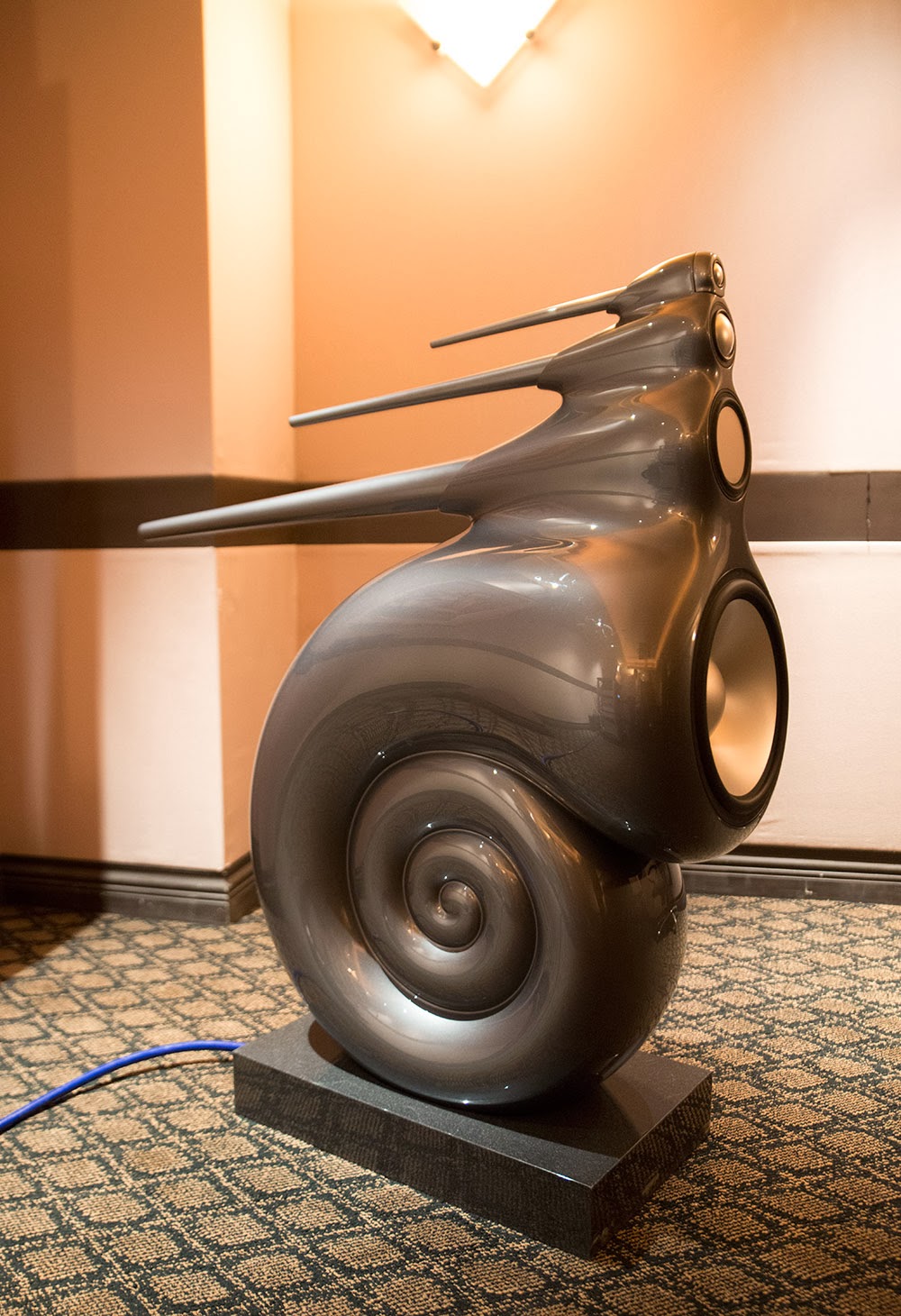
Archimago's Musings: MUSINGS: Saturday AM B&W Nautilus Listening

Archimago's Musings: MUSINGS: Saturday AM B&W Nautilus Listening
A large rear chamber behind the driver with modest on-side absorption material to allow the rear wave to expand without interference, attached to a tapered tube/shape with loose rear absorption material to reduce resonances ..... seems to be a good design. In a large cabinet, a midrange chamber which starts full width and quickly tapers(triangle) to the rear seems simple to construct. A simple solution in common use is to slant the panel behind the midrange to end into one rear corner as Zaph does on his SB12.3 MTM-W design.In Lenard Audio TL, a high ratio exponential taper with closed end simulates surprisingly well, regardless of tuning or stuffing.
Attachments
I am sorry to say that I haven't heard them. It is a milestone among speakers!
I have. Let me put it this way : they absolutely wipe the floor with any and all of the other B&W loudspeakers, including all the latest top of the line ones.
Of course, this will be due to a large number of factors, and not the bass driver loading alone. But still, they're a force to be reckoned with, even 20+ years on.
Marco
IINM, the titular and pictured 4-way design is an active multi-amped system in which the question of BSC should be moot?
As for the more conventional (as far as woofer loading is concerned) 800 series, I've heard several since first introduced, and my only comment would be that thoroughly researched excellent driver / design of enclosures for individual pass bands is but one part of the puzzle. To be honest, the larger models left me a bit cold compared to say, Sonus Fabre at competing or lower prices.
As for the more conventional (as far as woofer loading is concerned) 800 series, I've heard several since first introduced, and my only comment would be that thoroughly researched excellent driver / design of enclosures for individual pass bands is but one part of the puzzle. To be honest, the larger models left me a bit cold compared to say, Sonus Fabre at competing or lower prices.
Last edited:
Has anyone heard these speakers and could report on the experience? Whoops just missed you... any others?
I have heard both Vivid Audio Giya G1 and G1 Spirit. Excellent detail, very dynamic. They don't lose composure all the way to beyond "can't bear it" levels. They are so far the only speakers that I think compare favourably to Yamaha NS-1000's resolution and low dynamic distortion. Except that they are a more complete speaker with higher power handling and SPL abilities.
FWIW, these speakers perform at a level that requires room acoustic treatment (and preferably some DSP EQ). Not because of its own shortcomings, but because the room becomes an inhibiting factor in realising its full potential. While I know the latter might be generalised for all loudspeakers, I believe a lesser loudspeaker would have reached its limits at a point where you could eke out more from the Vivids.
Vivid G1 Spirit
I have heard both Vivid Audio Giya G1 and G1 Spirit.
..it should be pointed out that it's the same designer for the enclosure (the B&W Nautilus and Vivid Audio's products): Laurence Dickie.
Vivid Video: JA Interviews Speaker Designer Laurence Dickie | Stereophile.com
Had a Client (bespoke Residence) years ago that hired a respected Audio systems firm to design /set up a whole house audio and automation setup.
~200k$ worth.. hardly trivial.
BW Nautilus speakers were spec'd. Client thought their odd shapes were interesting, Sales types claiming they were V good.
On start up Day we all went to listen.. Hey ! the hype was extravagent.
Minutes in.. Several Red faces in the room.. the Client proclaimed them as unacceptable.. crap even.
Refusing to accept, let alone pay for that low level of quality.
Emperor's clothes came to mind
To my ears .. mercifully I had no dogs in that audio race.. they were simply a memorable disapointment.
~200k$ worth.. hardly trivial.
BW Nautilus speakers were spec'd. Client thought their odd shapes were interesting, Sales types claiming they were V good.
On start up Day we all went to listen.. Hey ! the hype was extravagent.
Minutes in.. Several Red faces in the room.. the Client proclaimed them as unacceptable.. crap even.
Refusing to accept, let alone pay for that low level of quality.
Emperor's clothes came to mind
To my ears .. mercifully I had no dogs in that audio race.. they were simply a memorable disapointment.
Last edited:
..makes me wonder if they were given a few weeks worth of "run-in" or not.
Most HiFi Co.s (and particularly those that sell speakers) *really* need to do this (..perhaps it's a "dealer" thing?). I've heard (on several occasions) where a product went from "dull" and "flat" to "where did my room's front wall go?"
Ironically the absolute worst I've heard in this regard wasn't even a loudspeaker, rather an early Cello amplifier (brand new out of the box). It wasn't just disapointing, rather the sound was actually BAD: "chalky" "grainy" with zero depth and no "out of boudry" lateral extension. After a few months I popped-in the store and heard them again on the very same setup and it was completely different (in a good way).
Most HiFi Co.s (and particularly those that sell speakers) *really* need to do this (..perhaps it's a "dealer" thing?). I've heard (on several occasions) where a product went from "dull" and "flat" to "where did my room's front wall go?"
Ironically the absolute worst I've heard in this regard wasn't even a loudspeaker, rather an early Cello amplifier (brand new out of the box). It wasn't just disapointing, rather the sound was actually BAD: "chalky" "grainy" with zero depth and no "out of boudry" lateral extension. After a few months I popped-in the store and heard them again on the very same setup and it was completely different (in a good way).
Had a Client (bespoke Residence) years ago that hired a respected Audio systems firm to design /set up a whole house audio and automation setup.
~200k$ worth.. hardly trivial.
BW Nautilus speakers were spec'd. Client thought their odd shapes were interesting, Sales types claiming they were V good.
On start up Day we all went to listen.. Hey ! the hype was extravagent.
Minutes in.. Several Red faces in the room.. the Client proclaimed them as unacceptable.. crap even.
Refusing to accept, let alone pay for that low level of quality.
Emperor's clothes came to mind
To my ears .. mercifully I had no dogs in that audio race.. they were simply a memorable disapointment.
Well, they must have done something (very) wrong in that installation, then. Based on my own experience with them, I am pretty certain that placing the blame squarely at the Nautilus' feet was misguided.
The "break-in" period is essential but really for your brain, not the rubber bits.
When you demo stuff in your home, you should never start by playing something you know is great. Best even just to chat for a half-hour or play background music in that room.
Everybody knows that, right?
B.
When you demo stuff in your home, you should never start by playing something you know is great. Best even just to chat for a half-hour or play background music in that room.
Everybody knows that, right?
B.
Though I have no control, I'd like to keep this focused on a narrow technical point about the idea behind dissipating that rear wave as a means of reducing distortion, ringing or something.
I mean, if it works as sold, we should see it in waterfall or impulse responses, no?
Best,
E
I mean, if it works as sold, we should see it in waterfall or impulse responses, no?
Best,
E
- Home
- Loudspeakers
- Multi-Way
- Was Nautilus bunk?
